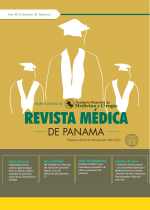Características clínicas y para clínicas de los pacientes con fiebre manchada por Rickettsia rickettsii en Panamá (1950-1951; 2004-2018)
Autores/as
DOI:
https://doi.org/10.37980/im.journal.rmdp.2019794Resumen
[Clinical and para clinical characteristics of patients with fever spotted by Rickettsia rickettsii in Panama (1950-1951; 2004-2017)]
Resumen
La fiebre manchada causada por Rickettsia rickettsii es por mucho la enfermedad transmitida por garrapatas más importante en América Latina y una de las zoonosis más relevante del continente. En Panamá esto es notorio si se considera que los casos confirmados de la misma se han registrado en dos series: 1950-1951, donde se presentaron cinco casos, donde los dos primeros fueron resultaron fatales, y de 2004-2017, donde se confirmaron 10 casos, con nueve fallecimientos. A pesar de lo anterior, la fiebre manchada causada por R. rickettsii es una enfermedad de baja prevalencia y está dentro de las enfermedades desatendidas. El diagnóstico oportuno de R. rickettsii en personas afectadas por la misma, incrementa la posibilidad de sobrevivencia del paciente; sin embargo, a pesar de su alto porcentaje de mortalidad, esta enfermedad es poco reconocida y no se cuenta con sospecha clínica. Con el objetivo de presentar sus características clínicas en Panamá, se analizan individualmente cada reportes de caso, incluyendo datos etarios, de localidad, síntomas descritos, análisis aplicados y tratamiento.
Abstract
The spotted fever caused by Rickettsia rickettsii is by far the most important tick-borne disease in Latin America and one of the most important zoonoses in the continent. In Panama this is notorious if it is considers that the confirmed cases have been registered in two series: 1950-1951, with five cases and two fatal; and 2004-2017, with 10 cases and nine deaths. Despite the above, spotted fever caused by R. rickettsii is a disease of low prevalence and is among the neglected diseases. The timely diagnosis of R. rickettsii in people affected by it, increases the possibility of survival of the patient; however, despite its high mortality rate, this disease is poorly recognized and there is no clinical suspicion. In order to present their clinical characteristics in Panama, each reports of case is analyzed individually, including age, location, symptoms described, applied analysis and treatment.
Publicado
Número
Sección
Licencia
Derechos autoriales y de reproducibilidad. La Revista Médica de Panama es un ente académico, sin fines de lucro, que forma parte de la Academia Panameña de Medicina y Cirugía. Sus publicaciones son de tipo acceso gratuito de su contenido para uso individual y académico, sin restricción. Los derechos autoriales de cada artículo son retenidos por sus autores. Al Publicar en la Revista, el autor otorga Licencia permanente, exclusiva, e irrevocable a la Sociedad para la edición del manuscrito, y otorga a la empresa editorial, Infomedic International Licencia de uso de distribución, indexación y comercial exclusiva, permanente e irrevocable de su contenido y para la generación de productos y servicios derivados del mismo. En caso que el autor obtenga la licencia CC BY, el artículo y sus derivados son de libre acceso y distribución.






